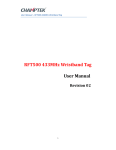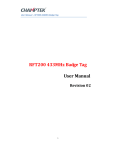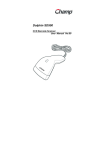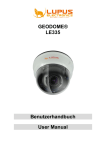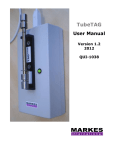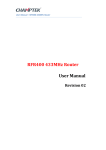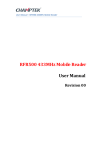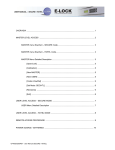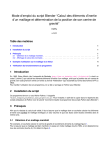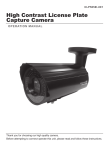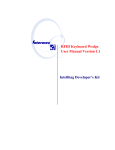Download RFR100 433MHz TCPIP Reader User Manual
Transcript
User Manual – RFR100 433MHz TCPIP Reader RFR100 433MHz TCPIP Reader User Manual Revision 02 User Manual – RFR100 433MHz TCPIP Reader User Manual Revision 00 01 02 Date Description 2009.1.15 Preliminary draft 2009.3.19 2009.8.17 Copyright Champtek may have patents, patent applications, trademark, copyrights, or other intellectual property rights covering in this document. The provision of this information does not grant you any license to these patents, trademarks, copyrights, or other intellectual properties. FCC Statement This device complies with part 15 of the FCC Rules. Operation is subject to the following two conditions: (1) This device may not cause harmful interference, and (2) this device must accept any interference received, including interference that may cause undesired operation of the device. FCC Statement This equipment has been tested and found to comply with the limits for a Class B digital device, pursuant to part 15 of the FCC rules. These limits are designed to provide reasonable protection against h armful interference in a residential installation. This equipment generates, uses and can radiate radio frequency energy and, if not installed and used in accordance with the instructions, may cause harmful interference to radio communications Any changes or modification not expressly approved by the party responsible could void the user's authority to operate the device. 2 User Manual – RFR100 433MHz TCPIP Reader Introduction RFR100 433MHz Reader by Champtek is a RFID monitoring system designed to receive all tags data through transmission frequency of 433.92 MHz. It was designed for easy setup, configuration, and usage . RFR100 provides Ethernet interface to communicate with backend host. Host can easily search all available Champtek reader s and setup related parameters. Besides, It made a significant achievement of the system throughput (Up to 160 tag-reports per second) to prevent from the data loss for the high-density implement. RFR100 built in smart channel clear detection function indicates strength of channel interference that reduce the t ime and cost to setup the system. Reader feedbacks all the RSSI value of the packet received from the tags that is useful for the application of the real time positioning system. RFR100 uses cyclic redundancy check to ensure the data integrity and provide API to reduce the time to design the application software. Features User configurable identification range ( 1m to 90m) Smart channel clear detection function Complete command set and API support Advanced two-layer anti-collision technique, identifying up to 160 tags per second 3 User Manual – RFR100 433MHz TCPIP Reader Specification Reader Communication Protocol Ethernet 10/100M Fast Ethernet Protocols TCP/IP, UDP, ICMP, ARP, DHCP Client, Telnet Operation frequency 433.92 MHz Signal Strength Default -30dbm Range Control Adjustable RSSI range (0 to -99dbm) Modulation GFSK Read Range Omni Angle Antenna 90m Physical Characteristics Length Width Height Weight Case 4.89” 3.09” 0. 98” 120g Aluminum + ABS Environmental Operation Temperature Storage Temperature -30℃ to 65℃ -40℃ to 80℃ LED Indicators Power LED TX/RX LED Link LED Power on indicator TX/RX indicator LAN indicator Electrical Power Power Consumption 5Vdc, 1.2A 1.2W Connectors Ethernet Antenna RJ-45 female to host SMA 4 User Manual – RFR100 433MHz TCPIP Reader Mechanicals TOP View Power LED – On when reader is powered. TX/RX LED – On while reader is transmitting or receiving a packet. LAN LED – Blink when there are network activities . Ethernet – RJ-45 Ethernet jack. Antenna – SMA connector Power – 5Vdc Reset Button – Hardware Reset the Reader Network Configuration This section will introduce how to configure the network connection of RFR100 by utility TCPIP.exe RFR100 default IP: 192.168.1.127 Run Network Utility “TCPIP.exe” Homepage: 5 User Manual – RFR100 433MHz TCPIP Reader Search devices 1. Broadcast Search If don’t know the IP of the device, can utilize broadcast to search all the devices in the LAN to configure the parameters. 2. Search by IP If know the IP of the device not in the same LAN, can search by IP to set the parameters. 6 User Manual – RFR100 433MHz TCPIP Reader Search result Select anyone of the device and will pop up a dialog to check password. Check Password: Default Password: 00000000 7 User Manual – RFR100 433MHz TCPIP Reader Connect to the target device to configure the parameters. Configuration page 1 1. Device Name 2. Network Setting (Notice: Do not change the value the DIO listen port 5001. ) 8 User Manual – RFR100 433MHz TCPIP Reader Configuration page 2 1. Reader Operation mode and listen port 2. Serial Setting ( Do not change the default setting) Configuration page 2 1. Change password (Default password is 00000000) 2. Change Device name 9 User Manual – RFR100 433MHz TCPIP Reader Utility Upgrade (if needed) Packet Format Head Reader ID Group Tag ID Status RSSI Data $ 000000~999999 00~63 000000~999999 * 00~99 ** End Code 0x0d 0x0a * “Status” indicates the tag ’s condition such as moving, still, etc. ** The content of “Data” depends on different groups of tag. Implementation Notice Keep away from potential RF radiators such as electronic / radio equipments for minimizing inte rference, i.e. engine, monitor etc, utilize the channel clear detection feature to pre -scan the interference and then choose the best place to setup the reader. And readers should be mounted at reasonable height for better performance. RFR100 supports wide range of antennas for different coverage areas, high quality SMA coaxial cable may be use to separate the antennas from Reader. 10 User Manual – RFR100 433MHz TCPIP Reader Recommends CAT-5/5E or CAT-6 high quality Ethernet wire cable for RFR100. RFR100 is typical indoor used, for outdoor environment the Reader can be protected in a NEMA enclosure. The operation performance will be reduced the negatively impacted by nature weather conditions such as moisture, excessive temperature. APIs Champtek also provides efficient C ++ APIs to reduce the time of software development. This section describes how to use the APIs to setup and control RFR100. Network Connection API Prototype DWORD con_connectdvc(char* ip, unsigned short port) Description Connect the remote reader with assigned IP and Port Parameter ip[input]: The address of the IP port[input]: The communication port of the reader Return value Connection ID (Program automatically assigns this connection ID to the reader) Null – Failed Prototype bool con_selectdvc( DWORD handle ) Description Select a specific reader before send a command Parameter Handle[input]: Connection ID Return value True False – Failed Prototype bool con_reconnect() Description Re-connect the selected device (ref. bool con_selectdvc) Parameter None Return value True False 11 User Manual – RFR100 433MHz TCPIP Reader Command API Prototype void param_settimeout(int timevalue) Description Setting the threshold of command timeout Parameter Timevalue[in]: Command timeout Return value None Prototype int prtcl_startdvc() Description Start the reader to transfer the tag data back to the host through Ethernet Parameter None Return Value 0 (Successful) – Successful operation 1 (Time out) – No response 2(Error) – Failed operation Prototype int prtcl_stopdvc() Description Stop the reader to transfer the tag data back to the host through Ethernet Parameter None Return value 0: Successful - operation successful 1: Timeout – No response 2: Error - Reader received command but failed. Prototype int prtcl_resetmcu() Description Software reset the reader Parameter None Return Value 0 (Successful) – Successful operation 1 (Time out) – No response 2 (Error) – Failed operation Comment After reset the reader, the Ethernet connection will be disconnected. Need to re-connect the reader for further operation. 12 User Manual – RFR100 433MHz TCPIP Reader Prototype int prtcl_resettcp() Description Software reset the Ethernet module Parameter None Return Value 0 (Successful) – Successful operation 1 (Time out) – No response 2 (Error) – Failed operation Comment After reset the Ethernet module, the Ethernet connection will be disconnected. Need to re -connect the reader for further operation. Prototype int prtcl_getidnumber( DWORD idnum ) Description Inquire the ID of the reader Parameter Idnum[out]: 000000~999999(decimal) Return value 0 (Successful) – Successful operation 1 (Time out) – No response 2 (Error) – Failed operation Prototype int prtcl_setidnumber( DWORD idnum ) Description Set the ID of the reader Parameter Idnum[in]: 000000~999999(decimal) Return value 0: Successful – Successful operation 1: Timeout – No response 2: Error – Failed operation 3: Illegal parameter - The parameter is illegal Prototype int prtcl_setRSSIrange( unsigned short range ) Description Set the receiving RSSI range of the reader Parameter range[in]: 00~99(decimal) Ex. If want to reader only send back the packet above -80dbm. Set range[in] to 80 Return value 0: Successful – Successful operation 1: Timeout – No response 2: Error – Failed operation 3: Illegal parameter - The parameter is illegal 13 User Manual – RFR100 433MHz TCPIP Reader Prototype int prtcl_getRSSIrange( unsigned short range ) Description Inquire the RSSI range setting of the read er Parameter range[out]: The receiving RSSI range of the reader Return value 0 (Successful) – Successful operation 1 (Time out) – No response 2 (Error) – Failed operation Prototype int prtcl_getfirmwareversion( char* version ) Description Inquire the firmware version of the reader Parameter version[out]: [Data Format: XX.XX] Return value 0 (Successful) – Successful operation 1 (Time out) – No response 2 (Error) – Failed operation Data Handling API Prototype int prtcl_rssi_start() Description Get the channel RSSI information into buffer Parameter None Return value 0: Successful - operation successful 1: Timeout – No response 2: Error - Reader received command but failed. Prototype int prtcl_rssi_stop() Description Stop receiving the channel RSSI information Parameter None Return value 0: Successful - operation successful 1: Timeout – No response 2: Error - Reader received command but failed. Prototype DWORD data_pop_msg(char* lpbuf, DWORD nSize) Description Move a tag packet from the buffe r to specific memory Parameter lpbuf: Tag packet nSize[in]: memory size Return value Tag Packet real size 0: No data in the buffer 14 User Manual – RFR100 433MHz TCPIP Reader Prototype DWORD data_pop_rssi() Description Get the RSSI message from the buffer Parameter None Return value RSSI message -1: No data in the buffer Prototype DWORD data_group (const char* cmsg, char* pdata) Description Get the group code from a specific packet Parameter cmsg[in]: Tag packet pdata: Group code Return value The length of group code 0: Failed Prototype DWORD data_tagid (const char* cmsg, char* pdata) Description Get the tag id from a specific packet Parameter cmsg[in]: Tag packet pdata: Tag ID Return value The length of tag ID 0: Failed Prototype DWORD data_tagstatus (const char* cmsg, char* pdata) Description Get the status from a specific packet Parameter cmsg[in]: Tag packet pdata: Tag status Return value The length of tag status 0: Failed Prototype DWORD data_rssi (const char* cmsg,char* pdata) Description Get the RSSI from a specific packet Parameter cmsg[in]: Tag packet pdata: RSSI value Return value The length of RSSI value 0: Failed 15 User Manual – RFR100 433MHz TCPIP Reader Prototype DWORD data_data (const char* cmsg,char* pdata) Description Get the data from a specific packet Parameter cmsg[in]: Tag packet pdata: Tag data Return value The length of tag data 0: Failed Prototype DWORD data_readerid (const char* cmsg,char* pdata) Description Get the reader id id from a specific packet Parameter cmsg[in]: Tag packet pdata: Reader ID Return value The length of reader ID 0: Failed Prototype DWORD data_routerid (const char* cmsg,char* pdata) Description Get the router id from a specific packet Parameter cmsg[in]: Tag packet pdata: Router ID Return value The length of router ID 0: Failed 16
















